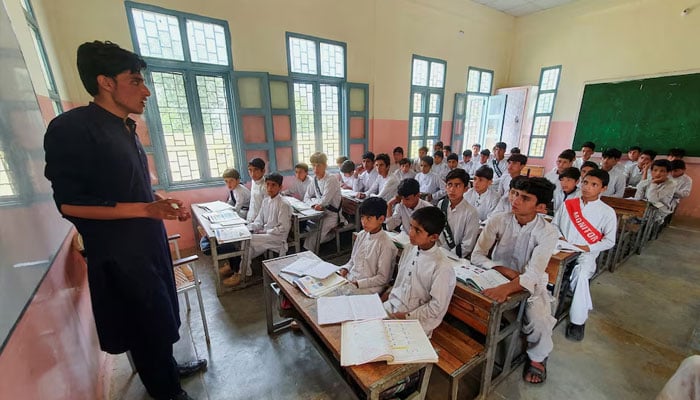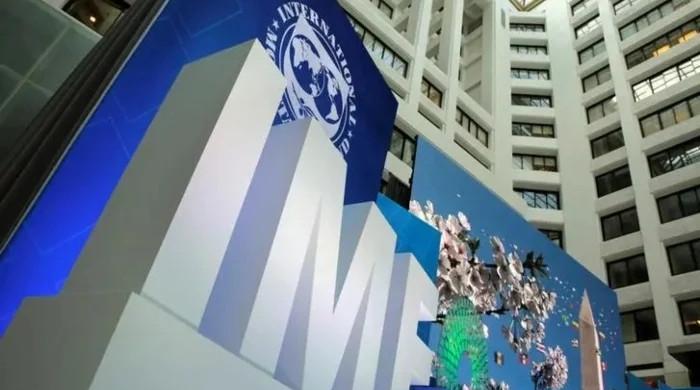The collapse of a curriculum
Traditional madrassa syllabus, Dars-e-Nizami, still relies on centuries-old texts in various key subjects
July 20, 2025

That the so-called Single National Curriculum (SNC), introduced by the Pakistan Tehreek-e-Insaf (PTI) government, was an exercise in futility is no longer news. Many critics, including me, have long highlighted its flaws. Now, a comprehensive review by Amjad Nazeer and Asad Khan provides both qualitative and quantitative evidence to reinforce this critique.
Previously, Anjum Altaf had taken on the task of reviewing the Pre-1 model textbooks. A consistent and critical voice in Pakistan's education discourse, Altaf has published extensively in newspapers and academic journals. In 2022, he released "Single National Curriculum: A Review of Pre-1 Model Textbooks", a timely intervention given that the SNC had been implemented for grades Pre-1 to 5 in the 2021–22 academic year.
Model textbooks across subjects accompanied this rollout. Altaf's work presented a detailed, page-by-page critique of the mathematics, English, and Urdu primers for the Pre-1 level.
Since Pre-1 forms the foundation of a child's entire educational journey, it is essential to examine the content and structure of these texts with care. Altaf’s review, published by Folio Books, could have served as a wake-up call for SNC advocates. Unfortunately, even after the government, the PTI failed to take the critique seriously. Model textbooks were printed and distributed to public schools across all provinces except Sindh.
Sindh was the only province to resist the federally imposed curriculum, asserting its constitutional right under the 18th Amendment to design its own. Although the textbooks developed in Sindh were marginally better, they too required significant improvement in both content and design. Altaf’s meticulous review highlighted the poor quality and incoherent structure of the Punjab Curriculum and Textbook Board (PCTB) materials, which were the primary focus of his criticism.
It is noteworthy that, according to the PCTB website, the board was chaired from 2016 to 2023 first by a retired lieutenant general (until 2021), then by a retired brigadier (until 2023). Altaf identified numerous inappropriate activities within the textbooks. For instance, on page 6 of the mathematics primer, students encountering the phrase "If you have a problem..." are given response options like: 'take a nap', 'pray', 'talk about happy things', 'exercise', 'count to ten', 'tell an elder', 'read a book' and 'play with toys'."
Altaf rightly argues that appropriate responses depend on the nature of the problem. Children must first be taught to assess situations before choosing a course of action. As he observed: "If a child is bitten by a snake, the appropriate response cannot be to take a nap, pray, or play with toys". This example illustrates a fundamental misunderstanding of child psychology and development by textbook authors.
In another example, Altaf examines pages eight to 17 of the mathematics textbook, which teach colours: blue, yellow, green, purple, orange, black and pink. Children are asked to colour a fish, and the teacher’s note states: "Discuss the benefits of eating fish with the children". Altaf reasonably comments that, while this is useful information, it is out of place in a mathematics primer. He also questions whether teachers themselves are equipped to explain the nutritional benefits of fish.
On page 11, in a section about the colour yellow, the teacher is instructed: "Make lemonade with the help of children and tell them about the health benefits of lemon". Altaf asks whether Pre-1 teachers in Pakistan are trained in nutrition or know what vitamins lemons contain and how they benefit the body. All of this comes from a mathematics primer under the SNC – a curriculum that claimed to bridge educational divides between rich and poor, and between public and private schools across Pakistan, from Gilgit to Gwadar.
Turning to the second work, "Education Concerns: SNC to NCP", co-authored by Amjad Nazeer and Asad Khan and published by Mashal Books under the leadership of Dr Pervez Hoodbhoy, this study fills a critical gap in understanding Pakistan's curriculum reforms. Nazeer, a respected social science researcher and human rights activist, heads the Institute of Development Research and Corresponding Capabilities (IDRAC). With support from the Taiwan Foundation for Democracy, this collaborative study documents the transition from the SNC to the so-called National Curriculum of Pakistan (NCP), a mere rebranding by the post-PTI coalition government.
The study begins by tracing the SNC's ideological and political roots. In its 2018 election campaign, the PTI promised a Uniform System of Education (USE) aimed at eliminating class-based disparities and providing equal opportunities to all students. While noble in principle, the initiative amounted to little more than cosmetic reform, lacking any structural depth.
As educationist Dr A H Nayyar writes in the study’s preface, the SNC betrayed its original promise of uplifting public schools to the level of the best private institutions. Achieving this would have required a major public investment, something Pakistan, which spends only about 2% of its GDP on education, has never been willing to make.
A major concern the study raises is that while debates over the SNC remained unresolved, the PTI government initiated another controversial policy move: the 2021 National Education Policy (NEP). The NEP’s background paper made grand claims of "revolutionising" education by boosting enrollment, reintegrating out-of-school children, building new schools, and promoting vocational and technical training.
Nazeer and his team collected extensive primary and secondary data from districts including Dera Ghazi Khan, Islamabad, Khanewal, Lahore, Layyah, Multan, Rawalpindi (Punjab), Karachi (Sindh), and Killa Abdullah and Pishin (Balochistan). While slightly Punjab-centric, the study remains broad, credible and methodologically sound. Interestingly, some executive district officers (EDOs) in Layyah, Multan, and Rawalpindi repeatedly delayed interviews — perhaps an indicator of institutional discomfort.
Chapter Two paints a grim picture: the net enrollment rate hovers around 70%, meaning nearly one-third of children are either out of school or in the wrong grade. Around four million students attend madrassas, most affiliated with mosques. Rather than confronting these deep-rooted issues, the PTI government sold the SNC as a cure-all, claiming input from over 400 education experts.
Independent analysts questioned this number, pointing out that if these experts were already embedded within the system, their perspectives lacked critical depth. As one commentator noted: "If the outcome is poor, it doesn’t matter whether you consulted 400 or 4,000 people". The government also never released the names of these consultants. In the case of the NEP, all it did was gather 45 vice-chancellors for a one-off seminar — another example of symbolic, rather than substantive, consultation.
Both the SNC and the NEP clearly overstepped constitutional boundaries. Following the 18th Amendment, education falls under provincial jurisdiction. Yet, the PTI government bypassed this framework, imposing a federal curriculum without fulfilling its own responsibilities, such as reforming the federal education system.
Imran Khan formally launched the SNC in August 2021, calling it a unifying force. The PTI also commissioned model textbooks aligned with the SNC and granted no-objection certificates to hundreds of publishers through the Punjab Textbook Board. Pakistan's 25 public examination boards were instructed to align assessments with the SNC. Yet, the study shows that fewer than 10% of madrassas offer a curriculum that integrates both religious and secular subjects.
The report also reviews the traditional madrassa syllabus, Dars-e-Nizami, which still relies on centuries-old texts in subjects like astronomy (falakiyat), economics (iqtisadiyat), philosophy (falsafa) and logic (ilm-e-mantiq) – all irrelevant to the contemporary world.
The study includes teacher surveys, many of which reveal scepticism about the SNC’s promise to end educational apartheid. Chapter Five, arguably the most compelling, focuses on textbook development and implementation, comparing practices across federal, provincial, public, private and religious school systems. Chapter Six critically assesses the curriculum content and Student Learning Outcomes (SLOs), while Chapter Seven delves into the middle school grades (6–8). Chapter Eight offers an overarching evaluation of curriculum concerns.
The books by Anjum Altaf, Amjad Nazeer and Asad Khan are a vital contribution to Pakistan’s education reform discourse. They deliver a strong indictment of the PTI government’s misguided efforts to centralise curriculum design under the guise of equity. From concept to execution, the SNC initiative represents a colossal misallocation of resources, which could have been better spent addressing the core challenges of Pakistan's struggling education system.
Disclaimer: The viewpoints expressed in this piece are the writer's own and don't necessarily reflect Geo.tv's editorial policy.
The writer holds a PhD from the University of Birmingham, UK. He posts @NaazirMahmood and can be reached at: mnazir1964@yahoo.co.uk
Originally published in The News









